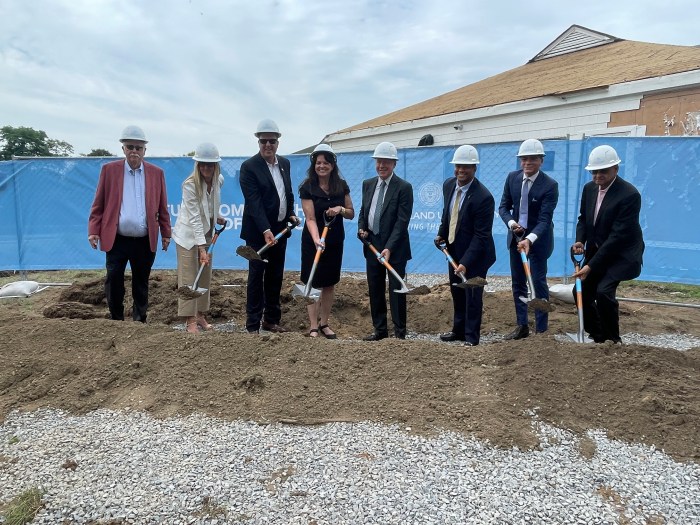For a number of years, Nassau County has been faced with a problem that seems to be getting worse every year: an aging demographic. To address this issue, County Comptroller George Maragos presented a report on his vision for what to do about the demographic trends afflicting the area at a meeting hosted by the Oyster Bay Civic Association on Thursday, Nov. 19.
“We’re aging as a population,” said Maragos. “The percent of seniors ages 65 and over is currently about 22 percent of our population and over the next 10 years, it’s expected to grow to about 28 to 29 percent. Our young people are going away to college and about 11 percent are not coming back. The number of school age children has declined by about 14 percent, and that trend is expected to continue as our young people leave for other regions. Those two demographics at both ends are going to start having very visible consequences on our economy.
”Maragos’ report, “An Economic Vision To Confront Nassau County’s Demographic Trends,” gives a 10-year outlook on where the county is headed and suggests some initiatives to “restore the exodus of our young adults, restore economic vitality and create good paying jobs.”
“We’re not an exciting place for young people to place down roots,” said Maragos, citing the industries that attracted jobs in the 1950s and 1960s. “Long Island is a hodgepodge of cottage industries. We do not have an economic identity. Nothing exciting is happening here. And it should; we certainly have the talent.”
According to Maragos’ projections, the overall population will decline by 3 percent by 2024, school age children (ages 0 to 9) will decline by 60,000, or 30 percent, compared to 2000, and the senior population will increase to 27 percent of the total, compared to 19 percent in 2000.
“What is it that we want to become? How should we reinvent ourselves?” asked Maragos. “In today’s global economy, unless you find something to be number one or number two at, to be the best in the world, you’re not going to be successful. Our recommendation is to look at ourselves inward, look at the natural advantages we have and try to be the best we can in selected industries.”
He said that, since Long Island has a “tremendous” healthcare system, the county government should invest in it and make it even better.
“The proposal is to model and select the healthcare industry, the biotech industry and the IT industry, and bring them together into clusters,” said Maragos. “My opinion is, if we start aiming to be the best in the healthcare industry, start investing in our infrastructure and start attracting some of the best minds in the world, we can do what some of the other regions have done.”
He stressed the importance of focusing on creating that identity and investing in it.
“And if it’s not those areas, let’s have a dialog and decide what it is, what are the major industries we are going to focus on as a government and begin investing in,” said Maragos.
The forum gave attendees a chance to ask questions regarding the report specifically—or any other financial questions related to the county—as well as to raise concerns they see affecting Long Island.
Many people in attendance at the presentation cited the high taxes and high cost of living in Nassau County as the major reason for the flight of younger people.
“It’s disappointing to me to know that when my children marry and settle, this is likely not the place they can do so,” said Dottie Simons, president of the Oyster Bay-East Norwich Chamber of Commerce.
Another attendee, who said she is almost 30 and works in Oyster Bay fulltime, said she could not afford to buy a house in Oyster Bay, even though that would be her first choice.
“Cost of living is a factor, but it is not the key factor,” said Maragos, noting that many young adults are moving to San Francisco and New York City, which are even more expensive, but are also more “exciting.” “We need to create that aura here and have those exciting growth opportunities here.”
Another man in the audience suggested that Maragos’ idea for job growth is “old school.”
“The newer people, like myself and younger, are looking for something different,” he said. “They’re not looking to work for large monopoly companies.”
He noted that, as well as the excitement factor, the traffic and commuting time is an aspect that doesn’t appeal to younger people.
Maragos said that his vision includes investing in high-speed public transportation as well as high-speed communication networks.
“I would maintain that even in our own little county, we can probably afford to borrow $5 billion, without raising property taxes, to support a huge capital investment in our infrastructure and transportation system,” said Maragos.
There were suggestions that perhaps the focus on individual downtown areas would help make communities thrive, such as Riverhead and Patchogue, which have more affordable housing.
Maragos said that affordable housing and bringing in certain businesses is an issue that towns need to address.
“We have more than 150 zoning jurisdictions, so there is no grand plan,” Maragos. “That is an area that needs to be addressed. We cannot afford to inhibit development.”































